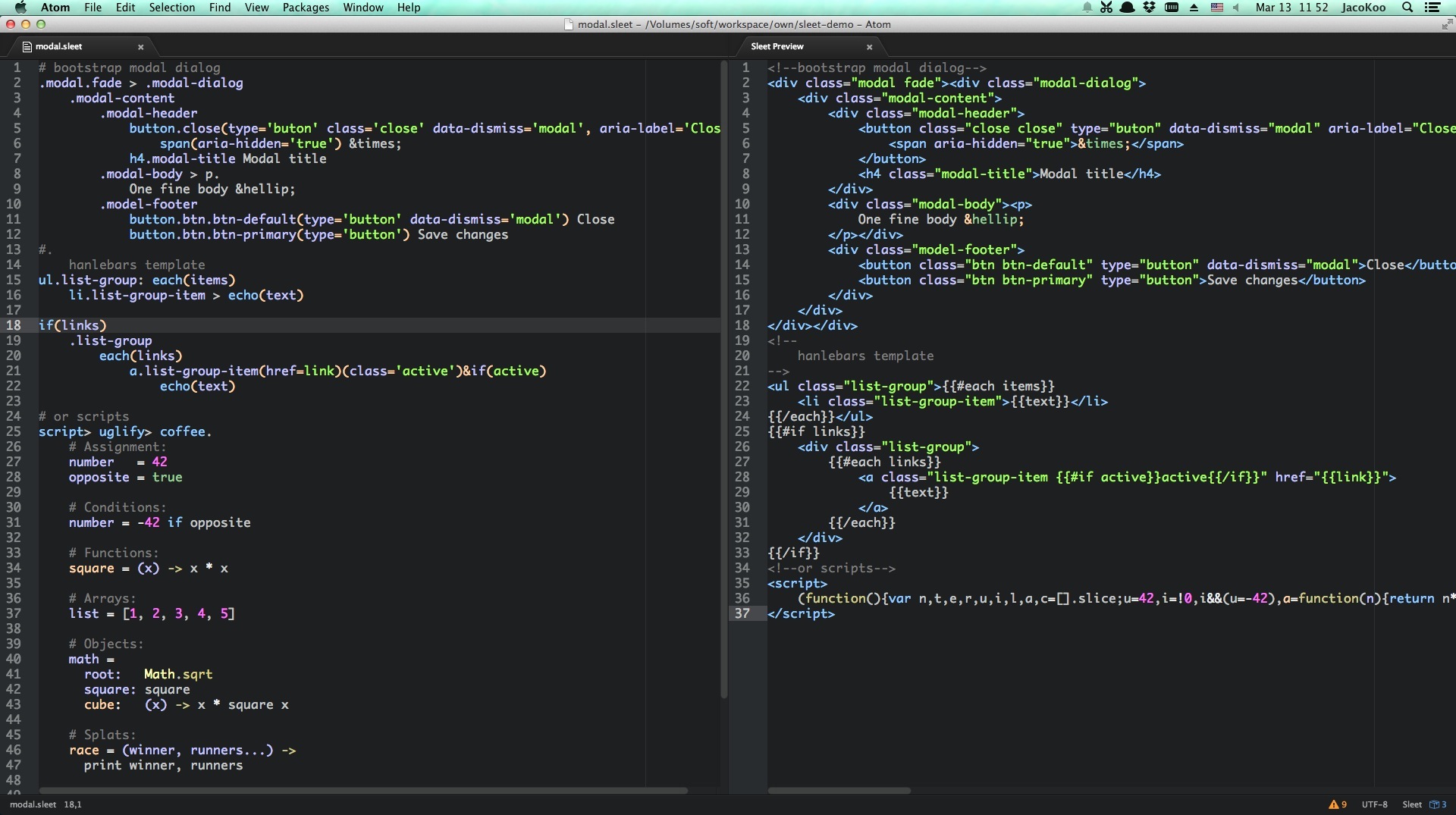Sleetjs¶
_____ _ _ _
/ ____| | | | | |
| (___ | | ___ ___| |_ | |___
\___ \| |/ _ \/ _ \ __| _ | / __|
____) | | __/ __/ |_ | |__| \__ \
|_____/|_|\___|\___|\__| \____/|___/
Sleetjs 是一种把代码编译成 HTML/XML 的语言
它不是一个模板引擎(像Jade那样), 所以它不能渲染数据.
但是你可以扩展一些标记(Tag), 使的编译出来的HTML中包含一些模板引擎需要的标记(如: {{#if}} <% if %>等),使的它可以用模板引擎来渲染数据.
相关资源¶
- github:sleetjs
- Sleet-Handlebars Sleet 的一个扩展, 用于把 Sleet 代码编译成 Handlebars 模板
- Atom-Sleet Sleet 与 Sleet-Handlebars 在 Atom 编辑器里的插件(包括语法高亮、保存时编译、预览等功能)
- Handlebars-Sleet 用于把已有的 HTML/HBS(Handlebars 模板) 转换成 Sleet 文件
截图¶

安装¶
安装前请确认你已经安装了 npm
$ npm install -g sleet
命令行用法¶
$ sleet [options] input1 [input2...]
Sleet 命令把输入方法编译成 html/xml 文件, 它可以同时处理多个输入文件或目录.
当指定目录时, 它会扫描指定目录与指定目录的所有子孙目录, 找出所有以 .sleet为扩展名的文件,并编译它们.
$ sleet -h
/usr/local/bin/sleet [options] input.st [input2.st...]
Options:
-o, --output The output directory
-w, --watch Watch file changes
-v, --version Show the version number
-h, --help Show this message
-o, --output 用来指定输出目录. 所有的输入文件都会把编译后的文件放到相应的输出目录中.
使用举例¶
-
把
src目录中的所有.sleet文件编译到dest目录的相对应的位置1$ sleet src/ -o dest/ -
监视
src目录中的文件, 如果有修改的话, 就把修改过的文件编译到dest目录的对应位置1$ sleet src/ -o dest/ -w
首行声明¶
Sleet 可以用首行声明的方式来确定用哪个Sleet扩展来编译当前文件、输出文件的后缀名以及编译 时用到的参数
默认情况下,使用sleet来编译,后缀名为html
#!sleet html
如果要配置用sleet-handlebars来编译,且指定后缀名与参数,可以按如下配置
#!sleet-handlebars html block=layout,view inline=date,shortDate
#!handlebars html block=layout,view inline=date,shortDate
语法¶
Sleet 是严格基于缩进的语言. 缩进相等的相邻标记为兄弟标记,缩进大的的标记是缩进小的标记的子孙标记.
一个缩进可以是任意多个空格或者一个tab符, 唯一的规则是, 你的所有缩进都要跟你一个缩进一样.
例如你的第一个缩进是4个空格, 那接下来所有的缩进都应该是4个空格的倍数, 否则会编译错误.
doctype html
html
head
meta(charset='utf-8')
title Welcom to Sleetjs
link(rel='stylesheet' href='index.css')
script(type='text/javascript') > uglify > coffee(bare=true).
number = 2
square = (x) -> x * x
console.log square number
body
.container > p.
This
is
a text block
#footer
p The end
会编译为:
<!DOCTYPE html>
<html>
<head>
<meta charset="utf-8"/>
<title>Welcom to Sleetjs</title>
<link rel="stylesheet" href="index.css"/>
<script type="text/javascript">
var number,square;number=2,square=function(r){return r*r},console.log(square(number));
</script>
</head>
<body>
<div class="container"><p>
This
is
a text block
</p></div>
<div id="footer">
<p>The end</p>
</div>
</body>
</html>
标记(Tag)¶
标记名的第一个字符可以是: [a-zA-Z$@_], 后面的字符可以为: [a-zA-Z0-9$_-].
例如:
html
@at1
$dollar2
_underscore3
<html>
<@at1></@at1>
<$dollar2></$dollar2>
<_underscore3></_underscore3>
</html>
标记名、类选择器、ID选择器都是可选的,但至少要提供其中一个。
#id
.class
#id2.class2
.class3#id3.class4
a#id3.class5
<div id="id">
<div class="class"></div>
<div id="id2" class="class2"></div>
<div id="id3" class="class3 class4"></div>
<a id="id3" class="class5"></a>
</div>
行内标记(Inline Tag)¶
用行内标记可以节省缩进。
有两种行内标记,分别是:行内子标记(>)、行内兄弟标记(+)
.container
div > #id > p text
#a1 + #a2
div > #a1 + #a2
<div class="container">
<div><div id="id"><p>text</p></div></div>
<div id="a1"></div><div id="a2"></div>
<div><div id="a1"></div><div id="a2"></div></div>
</div>
属性¶
一个标记可以有多个属性组
a.btn(href="#index")(class='btn-default') btn
<a class="btn btn-default" href="#index">btn</a>
如果属性值只包含:[a-zA-Z0-9$@_-], 那么引号是可以省略的
a.btn(href="#index")(class=btn-default target=_blank) btn
<a class="btn btn-default" href="#index" target="_blank">btn</a>
属性组可以包含多行,每一行代表一个属性,属性值的引号是可选的
a#btn(
href = #index
class = btn btn-default and-something-else
)(target=_blank) btn
<a id="btn" href="#index" class="btn btn-default and-something-else" target="_blank">btn</a>
每一个属性组可以跟一个限定符,但默认实现中,这些限定符都被省略了。这个机制是给扩展用的
例如,如果你用Handlebars模板引擎的话,可以这么用:
a(class=active)&if(data) text
<a {{#if data}}class="active"{{/if}}>text</a>
而如果你用underscore的话,它可以被编译成:
<a <% if (data) { %>class="active"<% } %>>text</a>
文本¶
行内文本
p these are text
<p>these are text</p>
文本块,标记后面直接跟一个英文句号:
p.
the indent of
text block must
equal or greater than parent's indent + 1
<p>
the indent of
text block must
equal or greater than parent's indent + 1
</p>
管道(pipeline)文本与管道文本块:
p
| pipeline
| text
| multiple lines
.child-of-p
a
|.
pipeline
text block
.child-of-a
<p>
pipeline
text
multiple lines
<div class="child-of-p"></div>
<a>
pipeline
text block
<div class="child-of-a"></div>
</a>
</p>
注释¶
单行注释与多行注释
# single line comment
.container
#.
multiple
line
comments
.row
.col-md-12 text
<!-- single line comment -->
<div class="container">
<!--
multiple
line
comments
-->
<div class="row">
<div class="col-md-12">text</div>
</div>
</div>
IE Conditional Comments¶
在 Sleet 中,有一个内置标记 ieif 可以用来写 IE条件注释:
ieif('lt IE 8') > script(src=hello.js)
@ieif('gte IE 8')
script(src=script.js)
<!--[if lt IE 8]><script src="hello.js"></script><![endif]-->
<!--[if gte IE 8]><!-->
<script src="script.js"></script>
<!--<![endif]-->
内置标记¶
这些内置标记被增强用来实现一些具体功能
自关闭标记(Self-closing)¶
以下这些都是自关闭标记
'area', 'base', 'br', 'col', 'command'
'embed', 'hr', 'img', 'input', 'keygen'
'link', 'meta', 'param', 'source', 'track', 'wbr'
文档类型(Doctype)¶
doctype(html)
<!DOCTYPE html>
<?xml version="1.0" encoding="utf-8" ?>
<!DOCTYPE html PUBLIC "-//W3C//DTD XHTML 1.0 Transitional//EN" "http://www.w3.org/TR/xhtml1/DTD/xhtml1-transitional.dtd">
<!DOCTYPE html PUBLIC "-//W3C//DTD XHTML 1.0 Strict//EN" "http://www.w3.org/TR/xhtml1/DTD/xhtml1-strict.dtd">
<!DOCTYPE html PUBLIC "-//W3C//DTD XHTML 1.0 Frameset//EN" "http://www.w3.org/TR/xhtml1/DTD/xhtml1-frameset.dtd">
<!DOCTYPE html PUBLIC "-//W3C//DTD XHTML 1.1//EN" "http://www.w3.org/TR/xhtml11/DTD/xhtml11.dtd">
<!DOCTYPE html PUBLIC "-//W3C//DTD XHTML Basic 1.1//EN" "http://www.w3.org/TR/xhtml-basic/xhtml-basic11.dtd">
<!DOCTYPE html PUBLIC "-//WAPFORUM//DTD XHTML Mobile 1.2//EN" "http://www.openmobilealliance.org/tech/DTD/xhtml-mobile12.dtd">
@include¶
@include 用来把另一个 sleet 文件引入到当前文件
# a.sleet
.input-group
span.input-group-addon @
input.form-control(placeholder=Username)
# b.sleet
.panel.panel-default
.panel-heading
h3.panel-title Panel title
.panel-body
@include ./a.sleet
<div class="panel panel-default">
<div class="panel-heading">
<h3 class="panel-title">Panel title</h3>
</div>
<div class="panel-body">
<div class="input-group">
<span class="input-group-addon">@</span>
<input class="form-control" placeholder="Username"/>
</div>
</div>
</div>
转换器(Transformers)¶
转换器用来把内容转换为相应的格式。内置支持的转换器有:coffee, 'markdown', 'uglify'.
Coffee¶
用来把 coffee script 编译为 javascript 代码
script
coffee.
foods = ['broccoli', 'spinach', 'chocolate']
eat food for food in foods when food isnt 'chocolate'
<script>
(function() {
var food, foods, _i, _len;
foods = ['broccoli', 'spinach', 'chocolate'];
for (_i = 0, _len = foods.length; _i < _len; _i++) {
food = foods[_i];
if (food !== 'chocolate') {
eat(food);
}
}
}).call(this);
</script>
Uglify¶
script
uglify.
(function() {
var food, foods, _i, _len;
foods = ['broccoli', 'spinach', 'chocolate'];
for (_i = 0, _len = foods.length; _i < _len; _i++) {
food = foods[_i];
if (food !== 'chocolate') {
eat(food);
}
}
}).call(this);
<script>
(function(){var c,o,a,l;for(o=["broccoli","spinach","chocolate"],a=0,l=o.length;l>a;a++)c=o[a],"chocolate"!==c&&eat(c)}).call(this);
</script>
你可以把它他组合起来使用:
script > uglify > coffee.
foods = ['broccoli', 'spinach', 'chocolate']
eat food for food in foods when food isnt 'chocolate'
<script>
(function(){var c,o,a,l;for(o=["broccoli","spinach","chocolate"],a=0,l=o.length;l>a;a++)c=o[a],"chocolate"!==c&&eat(c)}).call(this);
</script>
Markdown¶
html > body > markdown.
# Sleetjs
Sleetjs is a litte indent-based language that compiles into HTML/XML.
<html><body>
<h1 id="sleetjs">Sleetjs</h1>
<p>Sleetjs is a litte indent-based language that compiles into HTML/XML.</p>
</body></html>
API¶
to be continued
License¶
MIT